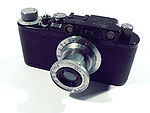
Leica II
Encyclopedia
The Leica II is a rangefinder camera
introduced by Leica in 1932. They were the first Leica cameras with an integrated rangefinder. Several models were produced over the years, in parallel with the Leica III
series from 1933.
The Leica II uses a coupled rangefinder distinct from the viewfinder. The viewfinder is set for a 50mm lens; use of shorter or longer lenses requires installing an alternate viewfinder on the accessory socket.
Rangefinder camera
A rangefinder camera is a camera fitted with a rangefinder: a range-finding focusing mechanism allowing the photographer to measure the subject distance and take photographs that are in sharp focus...
introduced by Leica in 1932. They were the first Leica cameras with an integrated rangefinder. Several models were produced over the years, in parallel with the Leica III
Leica III
The Leica III is a rangefinder camera introduced by Leica in 1933, and produced in parallel with the Leica II series. Several models were produced over the years, with significant improvements....
series from 1933.
The Leica II uses a coupled rangefinder distinct from the viewfinder. The viewfinder is set for a 50mm lens; use of shorter or longer lenses requires installing an alternate viewfinder on the accessory socket.
| Model name | Manufacturing dates | Features or improvements | |
|---|---|---|---|
| Leica D (Leica II) | 1932–1948 | like III but without slow speeds on frontal dial |  |
| Leica IIc | 1948–1951 | Die-cast Die casting Die casting is a metal casting process that is characterized by forcing molten metal under high pressure into a mold cavity. The mold cavity is created using two hardened tool steel dies which have been machined into shape and work similarly to an injection mold during the process... body like the IIIc Leica III The Leica III is a rangefinder camera introduced by Leica in 1933, and produced in parallel with the Leica II series. Several models were produced over the years, with significant improvements.... |
|
| Leica 250 DD Leica 250 Reporter The Leica 250 Reporter is a body variant of the Leica screw mount rangefinder. It was designed to take bulk film by rolls of 10 metres, allowing 250 exposures. The film was charged in special film cassettes .... |
– | Leica II-based Leica 250 Reporter | |
| Leica IIf | 1951–1956 | Similar to the IIIf, without the slow speed dial |  |

